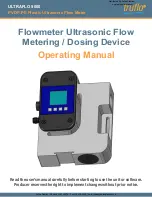
VNA concepts and features
R&S
®
ZNL/ZNLE
254
User Manual 1178.5966.02 ─ 19
●
For a
TRL calibration with 2 Lines
, a second Line standard must be measured in
addition.
●
For higher precision at low frequencies, the Reflect and Match standards at both
ports and the Through must be measured. See also
The TRL calibration is valid when the standards for a TRL calibration with 1 line have
been measured. The TRL extensions are applied automatically if the necessary stand-
ards have been measured.
Example: TRL calibration with two and three Lines
If several Lines with different lengths are measured, the analyzer automatically divides
the calibrated range into segments. The calibration data of the longest line is applied to
the lowest segment, the calibration data of the shortest line to the highest segment.
The calibration sweep segments for two Lines with electric lengths l
long
and l
short
(l
long
>
l
short
) are obtained as follows (the Through standard is assumed to be of length l
thr
):
●
The longer Line can be used up to a frequency f
long
where its transmission phase is
equal to 160 deg. This frequency is equal to
f
long
= 4*c
0
/[9*(l
long
– l
thr
)].
●
The shorter Line can be used from a frequency f
short
where its transmission phase
is equal to 20 deg. This frequency is equal to
f
short
= c
0
/[18*(l
short
– l
thr
)].
●
The border between the two frequency segments f
div
is calculated as the geometric
mean of f
long
and f
short
, i.e.
f
div
= sqrt(f
long
* f
short
).
The formulas are also applied if f
long
< f
short
.
For a TRL calibration using three Lines with different length, the allowed frequency
ranges are calculated in an analogous manner to obtain three (ideally overlapping) fre-
quency ranges. The borders between two adjacent frequency ranges are calculated as
the geometric mean of the frequency limits f
long
and f
short
of the two ranges.
A second or third Line in the list does not mean that you have to measure two or three
Line standards. If the calibrated frequency range is small enough, the calibration is
valid when the analyzer has acquired correction data for a single Line standard.
The Match and Sliding Match standards are not necessary for TRL calibration. How-
ever, for higher precision at low frequencies they must be measured.
Calibration
















































